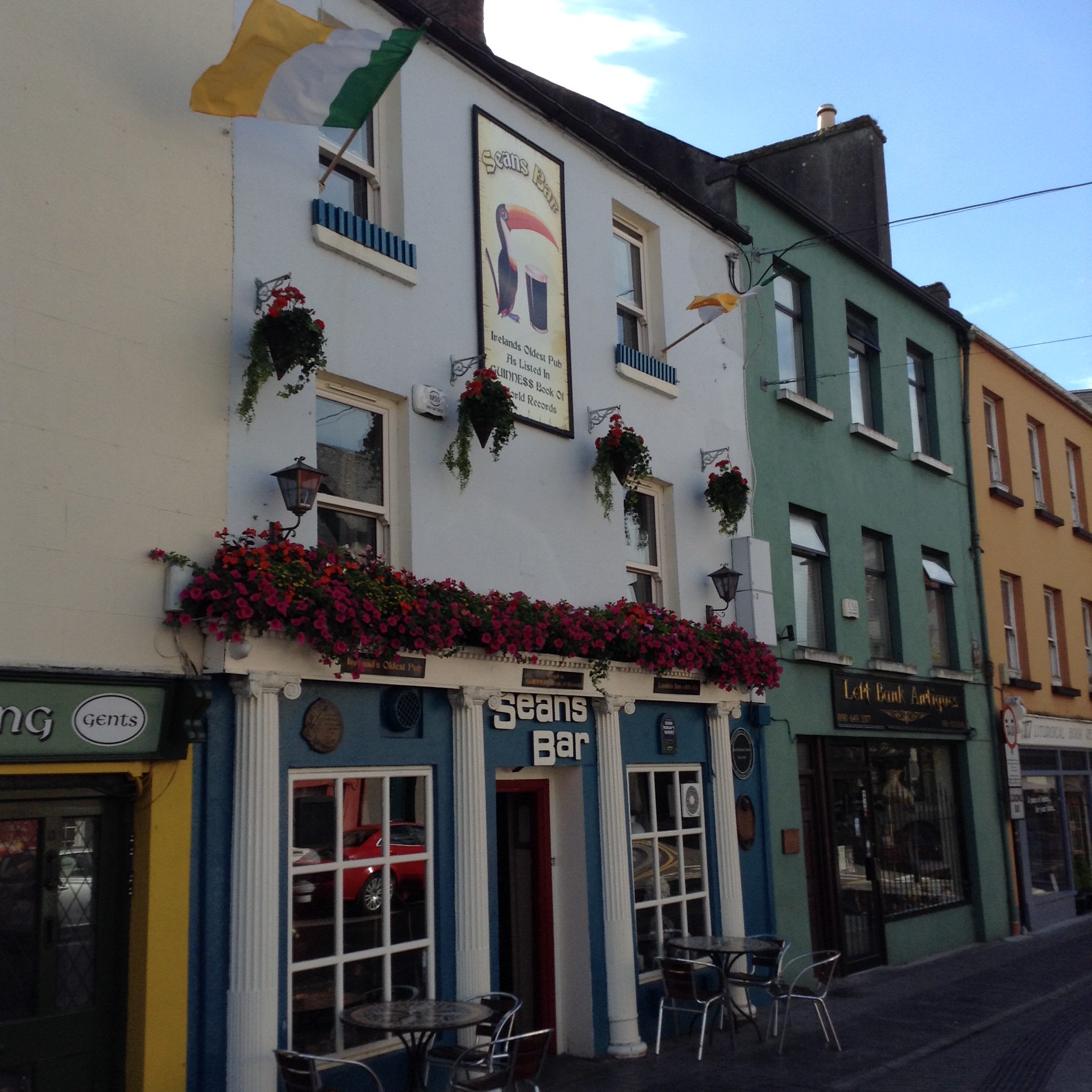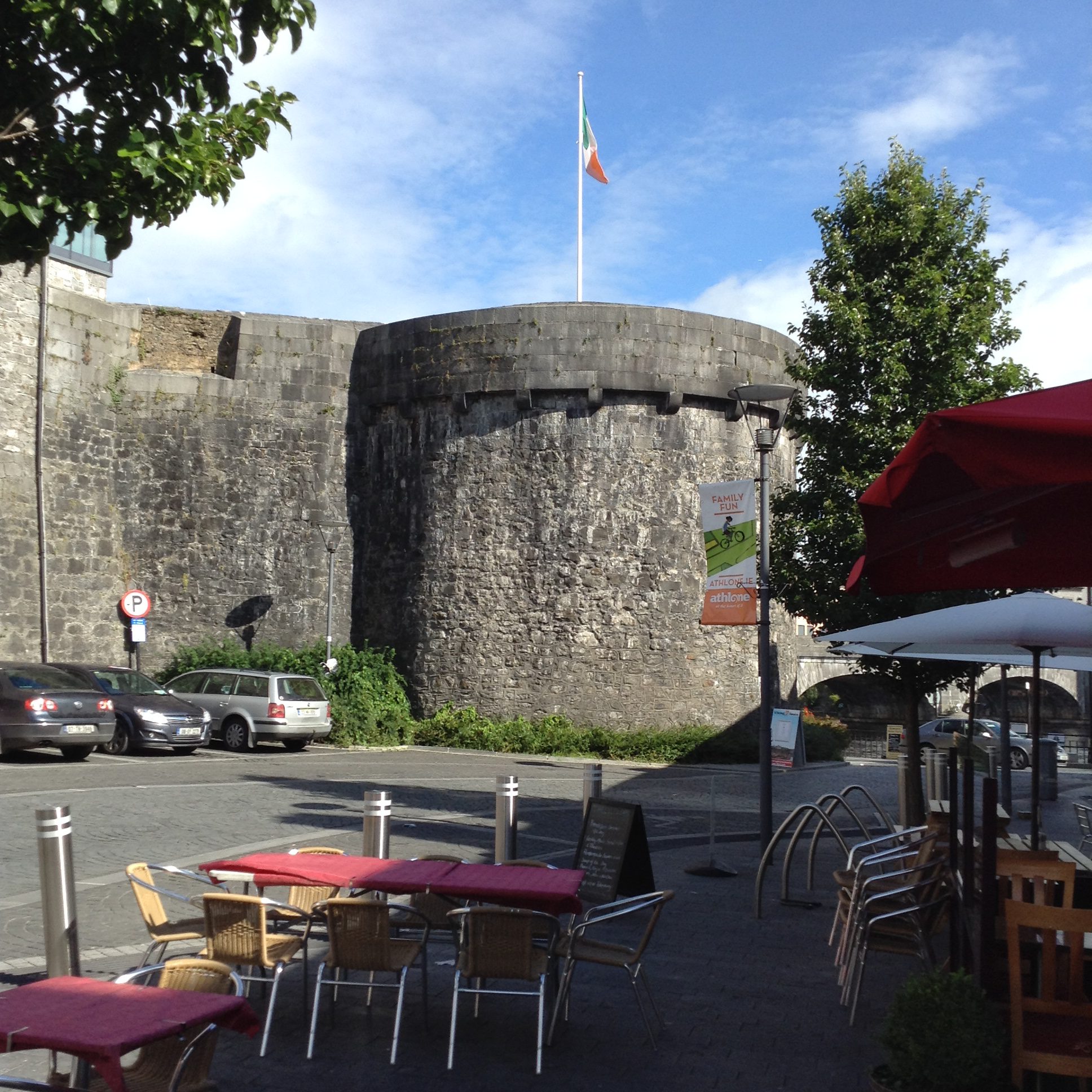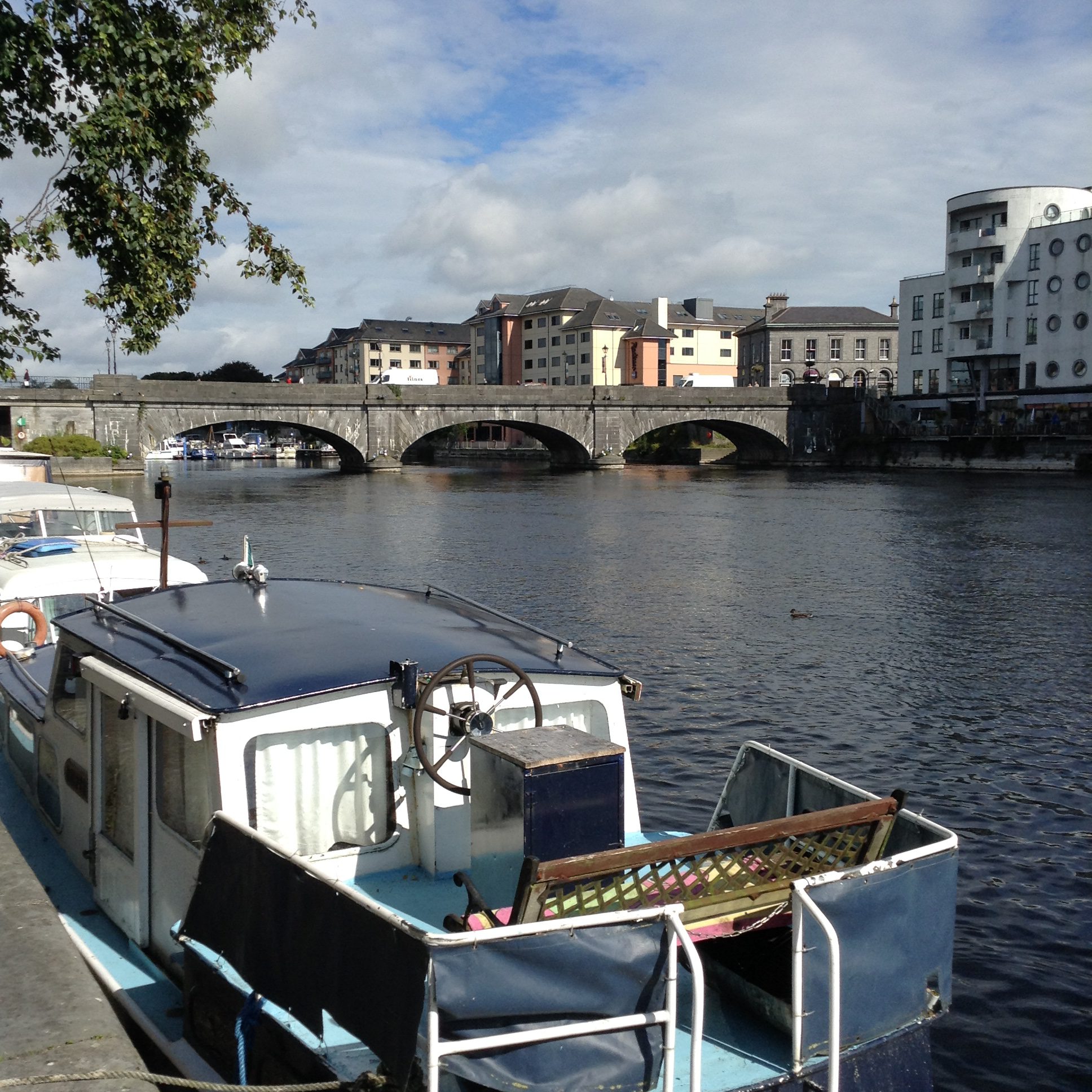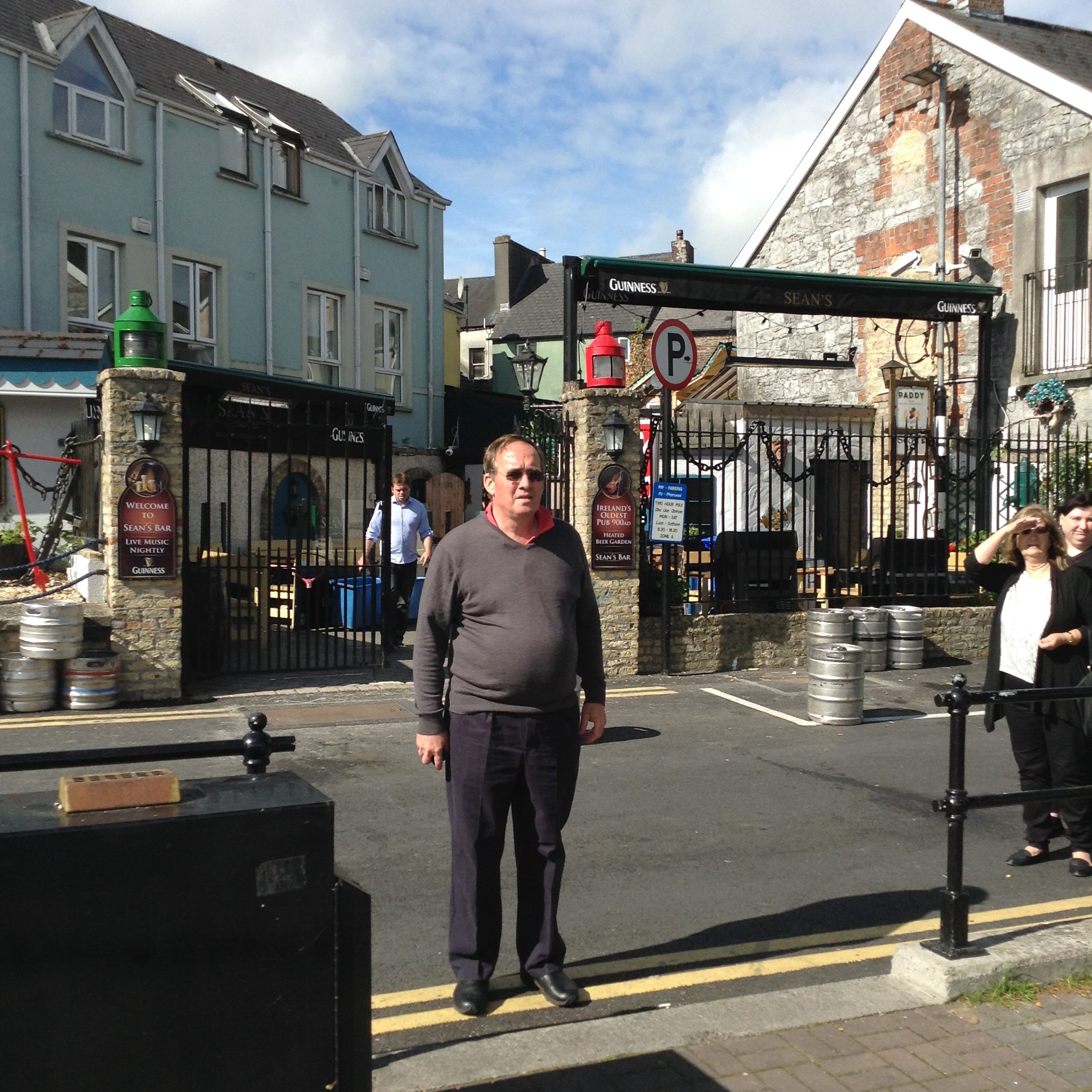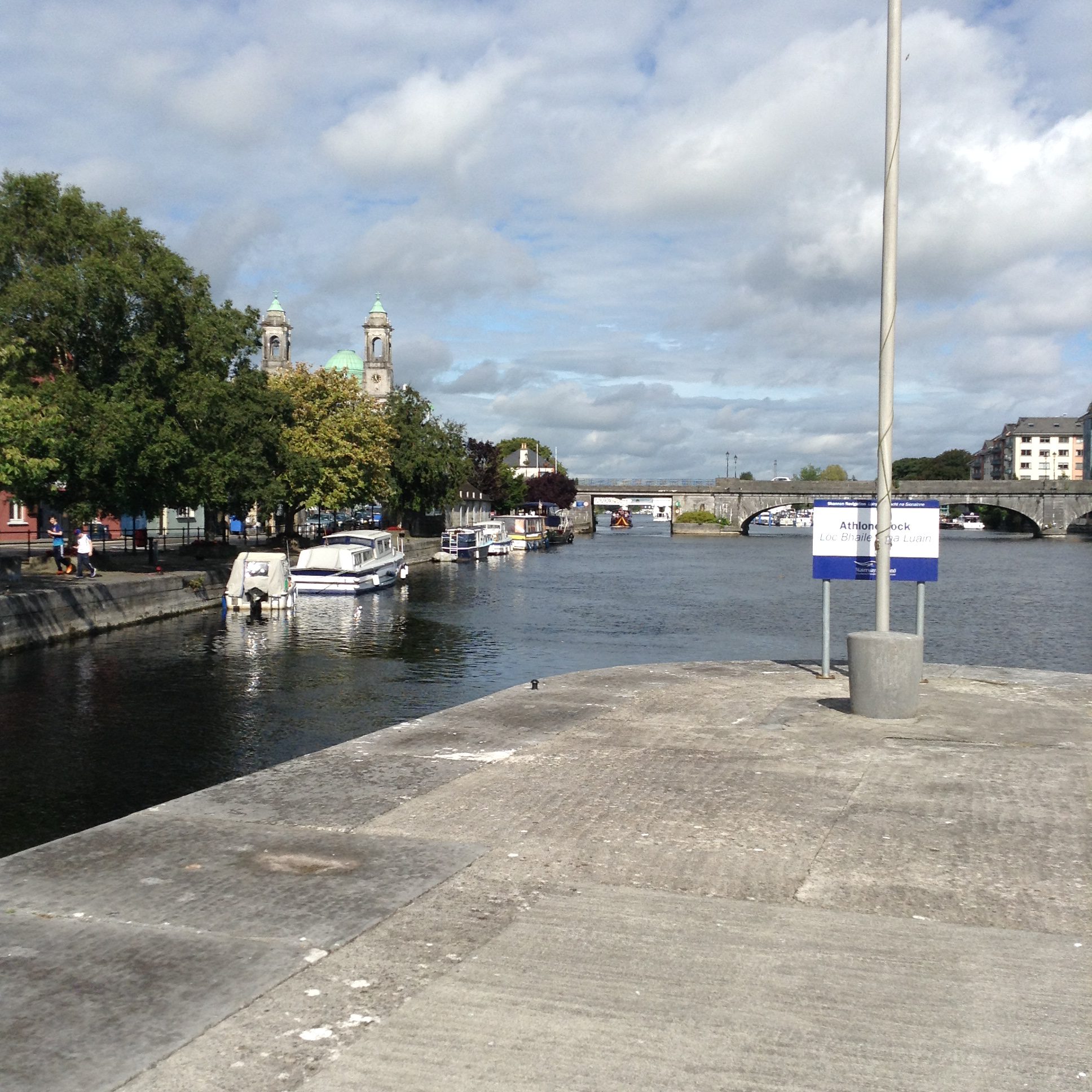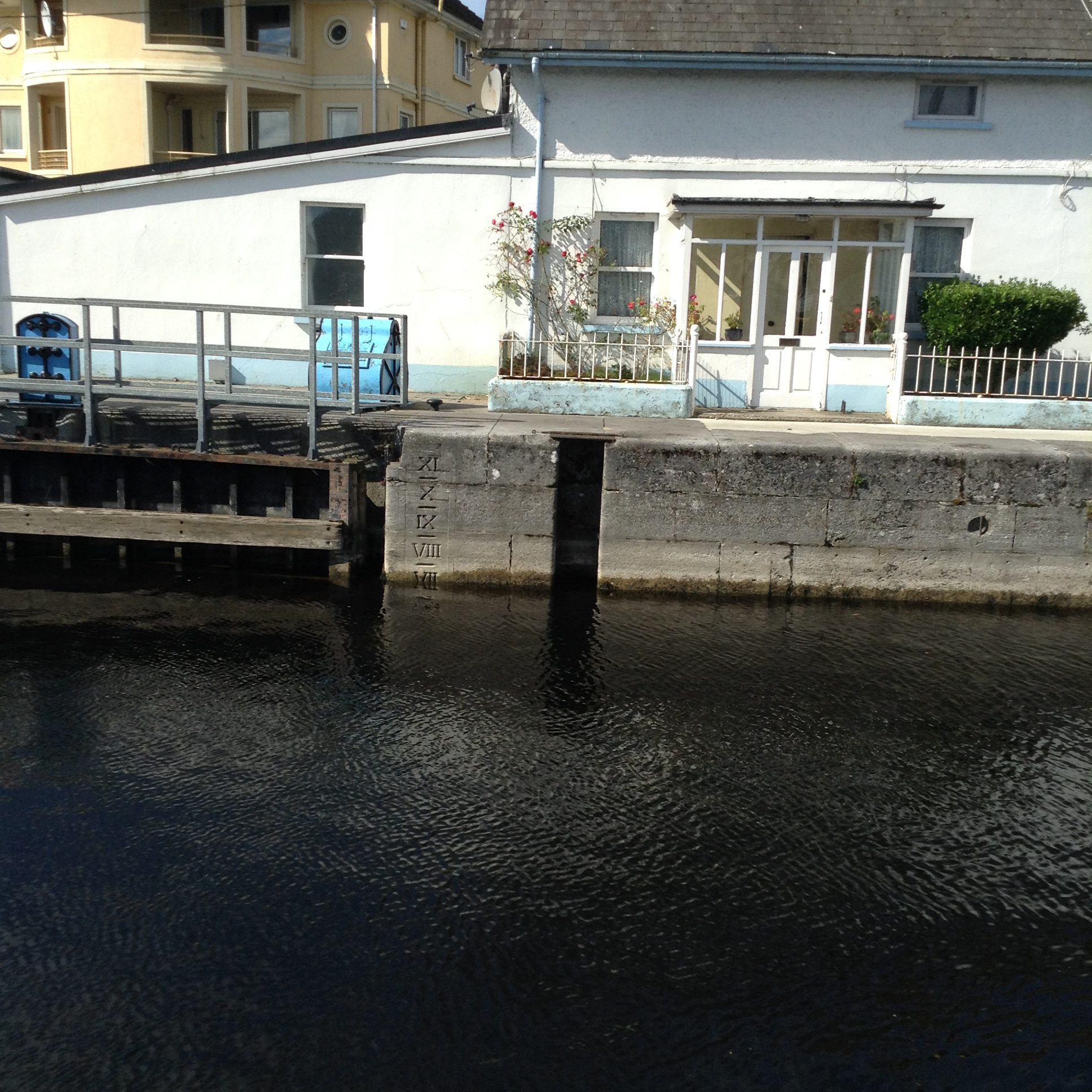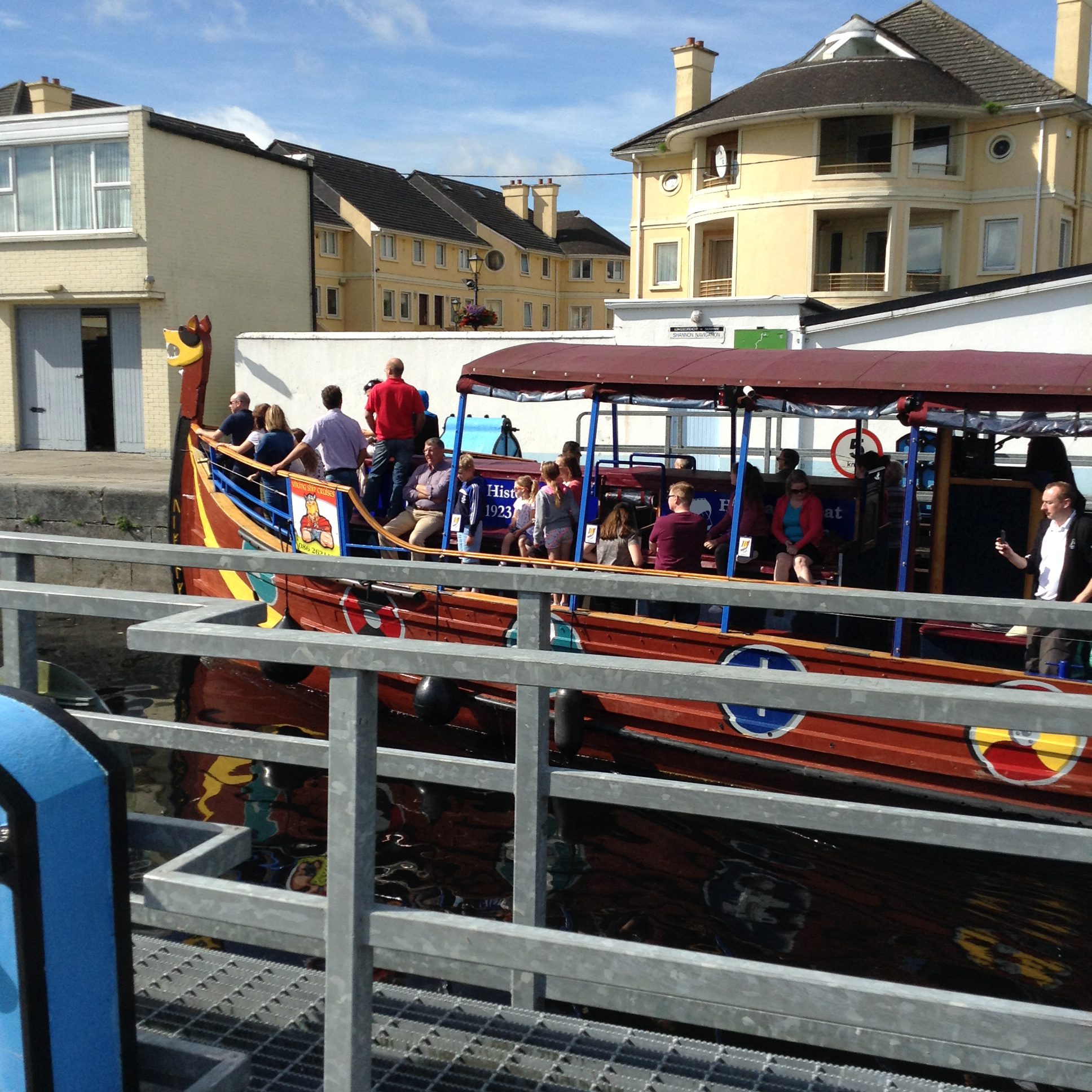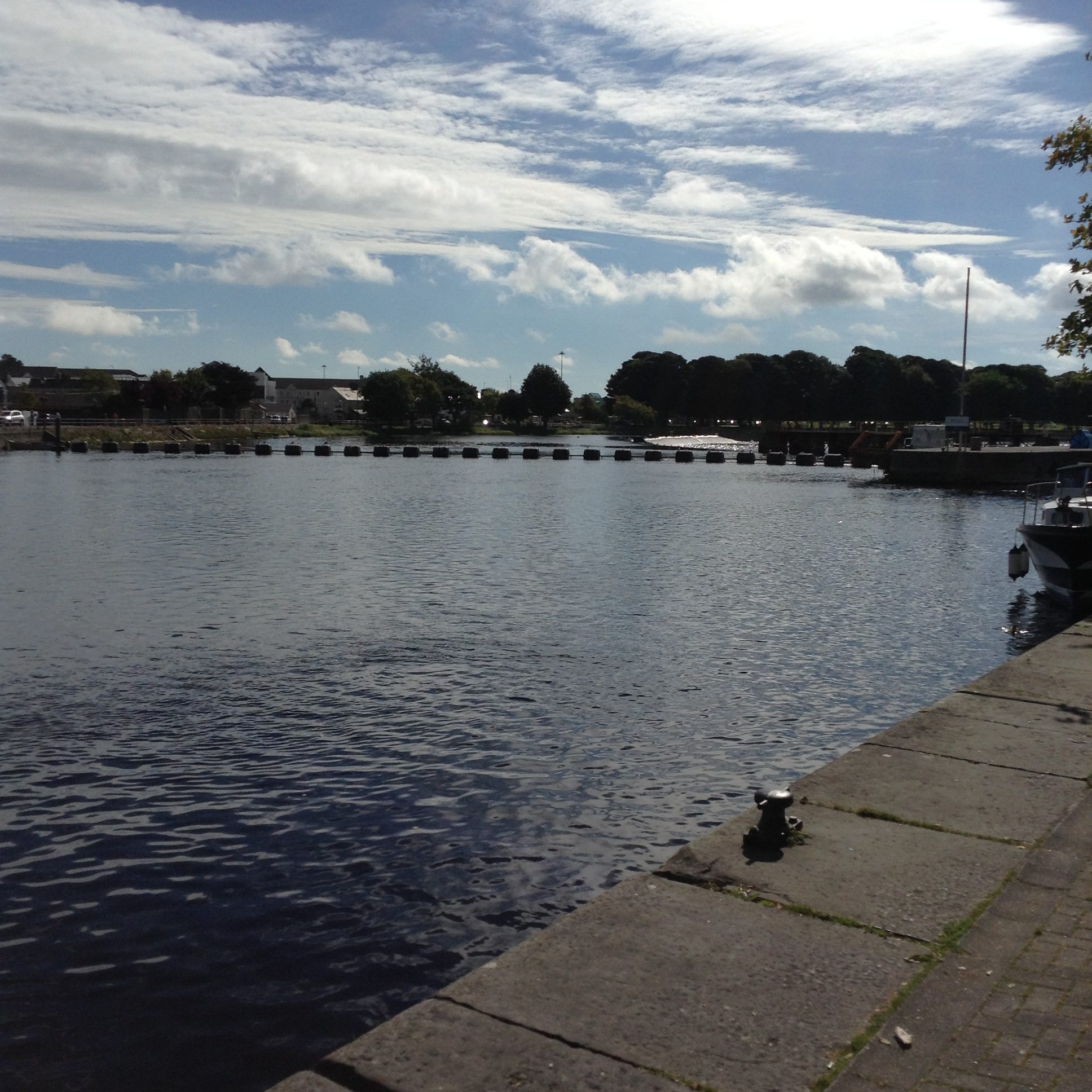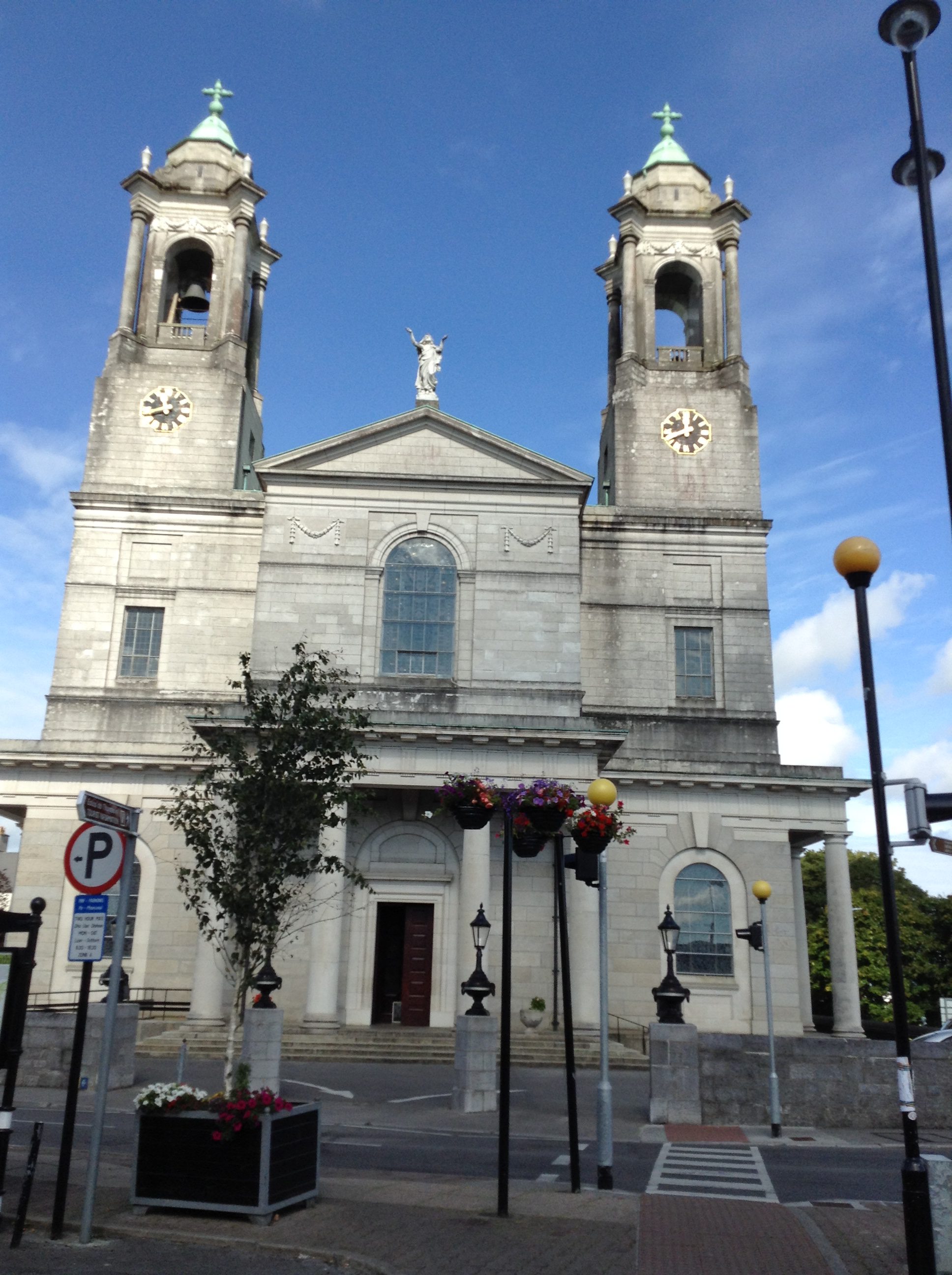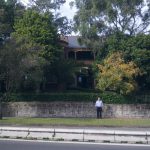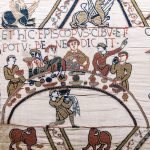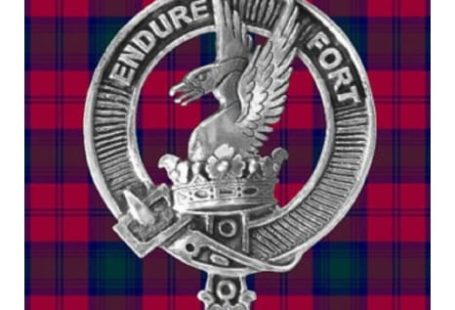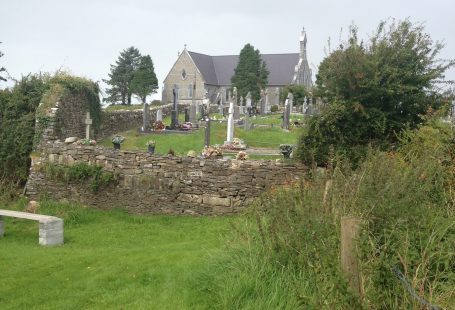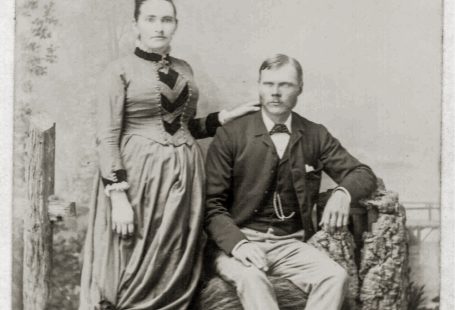Charles Farrell is my husband Geoffrey Philip Farrell Rundle’s 3 x great grandfather and it has been an honour for me to undertake this Irish research on his behalf. As with all my family research my goal has been to take our family back to its origins in an attempt to find where we came from, and in which villages our family lived. My earliest endeavor for the Farrell family came up with an amazing connection for Charles Farrell in Ireland. It was a simple matter of placing Charles Farrell’s name into the National Archives of Ireland search engine, with an immediate result of six references, each with plea letters written to the Chief Secretary’s Office, attached to the English Government, for protection, including migration pleas to Australia as a matter of urgency. One further letter from 1823 is still pending in their “test” website and I await this further information.
http://www.nationalarchives.ie/search-the-archives/
Ref: CSO/RP/1820/562 5 items
15 May 1820-20 Sep 1820; H Hobhouse, Secretary of State’s Office, London: petition of Charles Farrell, Mullingar, County Westmeath, for passage to New South Wales, Australia
Letter from Henry Hobhouse, Secretary of State’s Office, Whitehall, London, to William H Gregory, Under Secretary of Ireland, Dublin Castle, enclosing petition of Charles Farrell, Mullingar, County Westmeath, to King George IV, requesting order for passage to New South Wales, Australia, as he fears retribution for providing information to government on illegal activity in Ireland; includes petition from Farrell to Charles Grant, Chief Secretary, Dublin Castle, asking for relief and relating that ‘a fellow came to my Door some nights back and said there should be fire put in my house and burn it’; also short note to state that it would be ‘imprudent’ to send Farrell to New South Wales, as his life might be at risk should it be discovered that he provided information.
Ref: CSO/RP/1820/578 1 item
29 Oct 1820; Charles Farrell, inspector of linen, Mullingar, County Westmeath: for passage to colony for safety reasons
Petition of Charles Farrell, inspector of linen, Mullingar, County Westmeath, to Charles Grant, Chief Secretary, Dublin Castle, requesting passage to one of His Majesty’s colonies in order to avert consequences of being branded a government informer; claims to have identified fraud in the post office and illegal practices used by distillers to avoid payment of revenue taxes.
Ref: CSO/RP/SC/1821/569 4 items
22 Jul 1821-17 Nov 1821; File of papers relating to Charles Farrell, Dublin, and his offer of information on the disturbances across the country
File of papers relating to Charles Farrell, Dublin, and his offers of information concerning disturbances in the country. Includes letter from Farrell, to Charles Grant, Chief Secretary, Dublin Castle, stating that he has been marked out for suspicion, because of his assistance to government, 25 October 1821. Also includes memorandum from Major Henry Charles Sirr, chief police magistrate, Dublin, expressing his opinion that Farrell’s various claims are true, 10 November 1821; also memorandum from Thomas Thompson, solicitor to the General Post Office, Dublin, concerning information provided by Farrell in 1819, concerning the illicit carrying of letters and parcels by the coachmen and drivers of coaches and jaunting cars between Longford and Dublin, 17 November 1821.
Ref: CSO/RP/1822/141 4 Items
30 Jan 1822-17 Aug 1822; Letter from Charles Farrell, [linen inspector for County Westmeath], 25 Dawson Street, Dublin, requesting free passage on ship for New South Wales, Australia
Letter from Charles Farrell, [linen inspector for county Westmeath], 25 Dawson Street, Dublin, to Henry Goulburn, Chief Secretary, Dublin Castle, requesting free passage on a ship bound for New South Wales, Australia: claims to have provided information on illegal activity and is consequently ‘Eyed as a Government Spye [sic]’; encloses two copy letters from Goulburn provided in response to application; also includes memorial from Farrell, Athlone, County Westmeath, to William H Gregory, Under Secretary of Ireland, Dublin Castle, appealing for passage abroad and situation: also refers to a number of instances where his information was of use to government including details of a conspiracy against Dr Trench, ‘a great annoyance to thy Catholicks [sic] by proposing Sunday Schools & Books against them’.
Ref: CSO/RP/1822/1712
22 Jan 1822; Charles Farrell Jr, Athlone, County Westmeath: for permission to acquire land in New South Wales, Australia
Letter from Charles Farrell Jr, Athlone, County Westmeath, to Henry Goulburn, Chief Secretary, Dublin Castle, requesting that contact be made with the governor of New South Wales, Australia, Sir Thomas Brisbane, in order that he may have formal permission to acquire land on his arrival as a settler there.
Ref: CSO/RP/1822/1015 1 Item
6 May 1822; Charles Farrell, Athlone, County Westmeath: prospect of emigration to escape persecution
Petition of Charles Farrell, Athlone, County Westmeath, to Richard Wellesley, 1st Marquis Wellesley, Lord Lieutenant, Dublin Castle, expressing desire to have a letter of recommendation for presentation to Sir Thomas Brisbane of New South Wales, Australia, as he is subject to local persecution: indicates he holds the position of inspector for County Westmeath, under the Linen Board, but has attracted allegations of being ‘a Spye [sic] to the Government’ due to his offensive against ‘illegal idle associations’ and illicit distillation.
I knew that Charles Farrell had migrated to Australia aboard the Ardent and arrived in Hobart on 3 June 1824, before continuing to Sydney a few weeks later.
The information from the National Archives in Ireland about his dire position in Ireland reflected his migration date to Australia. The Australian story about Charles Farrell is included in another family chapter, entitled The Meredith and Farrell family of Australia. I immediately resolved to obtain copies of these original documents, even if it meant a trip to Dublin, Ireland to realise this goal.
In 2012 I came to a full stop in Ireland with research on my Wise lineage, a merchant family from Cork, and I decided to employ a genealogist, Mr Paul McCotter, from Waterford, Ireland, to do twenty hours of research, which also entailed a visit to the National Archives of Ireland (NAI), which are housed in Dublin. An extra request for a copy of Charles Farrell’s plea letter resulted in a report that included photographs of the original copy of one of his letters.
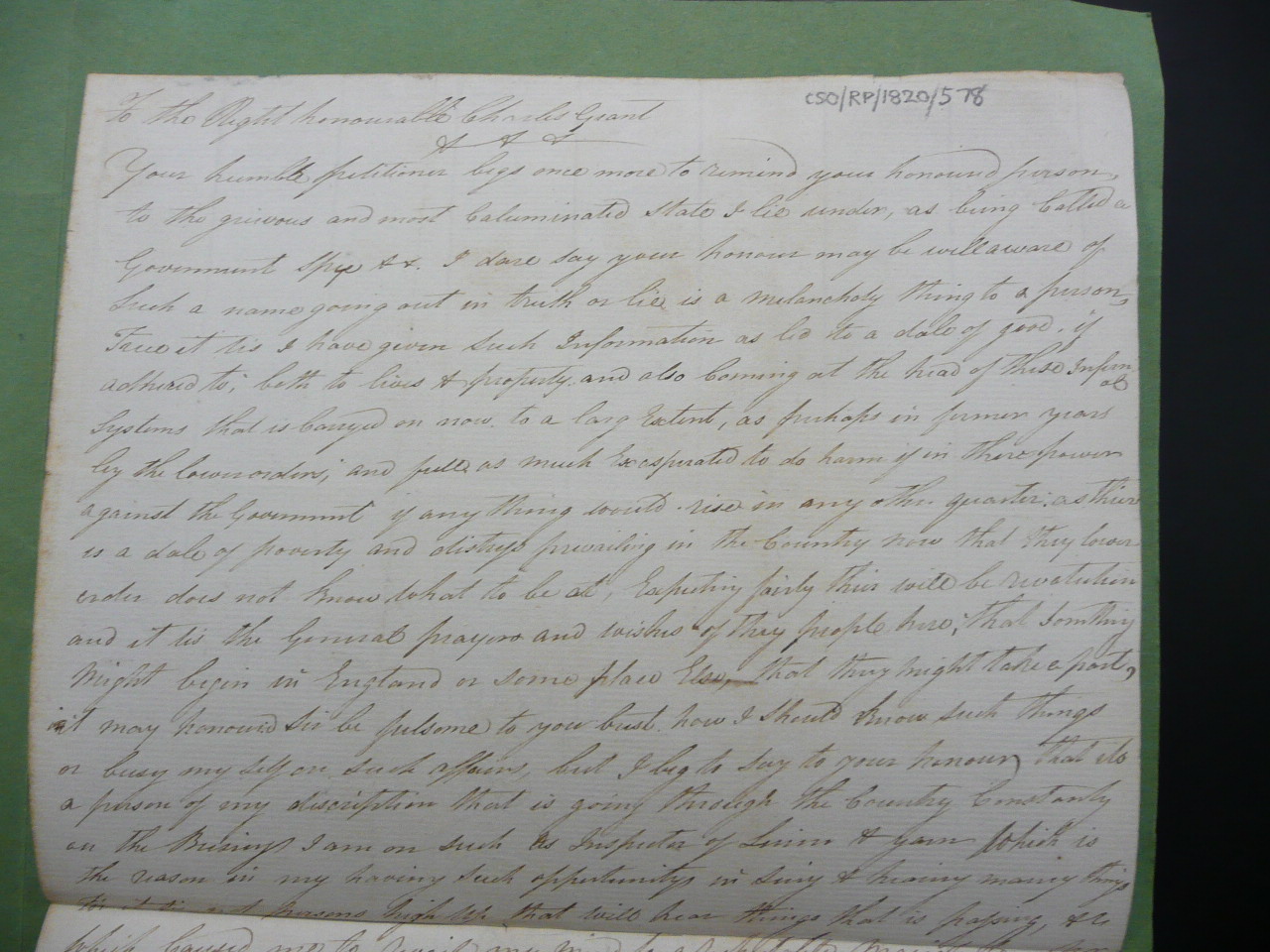
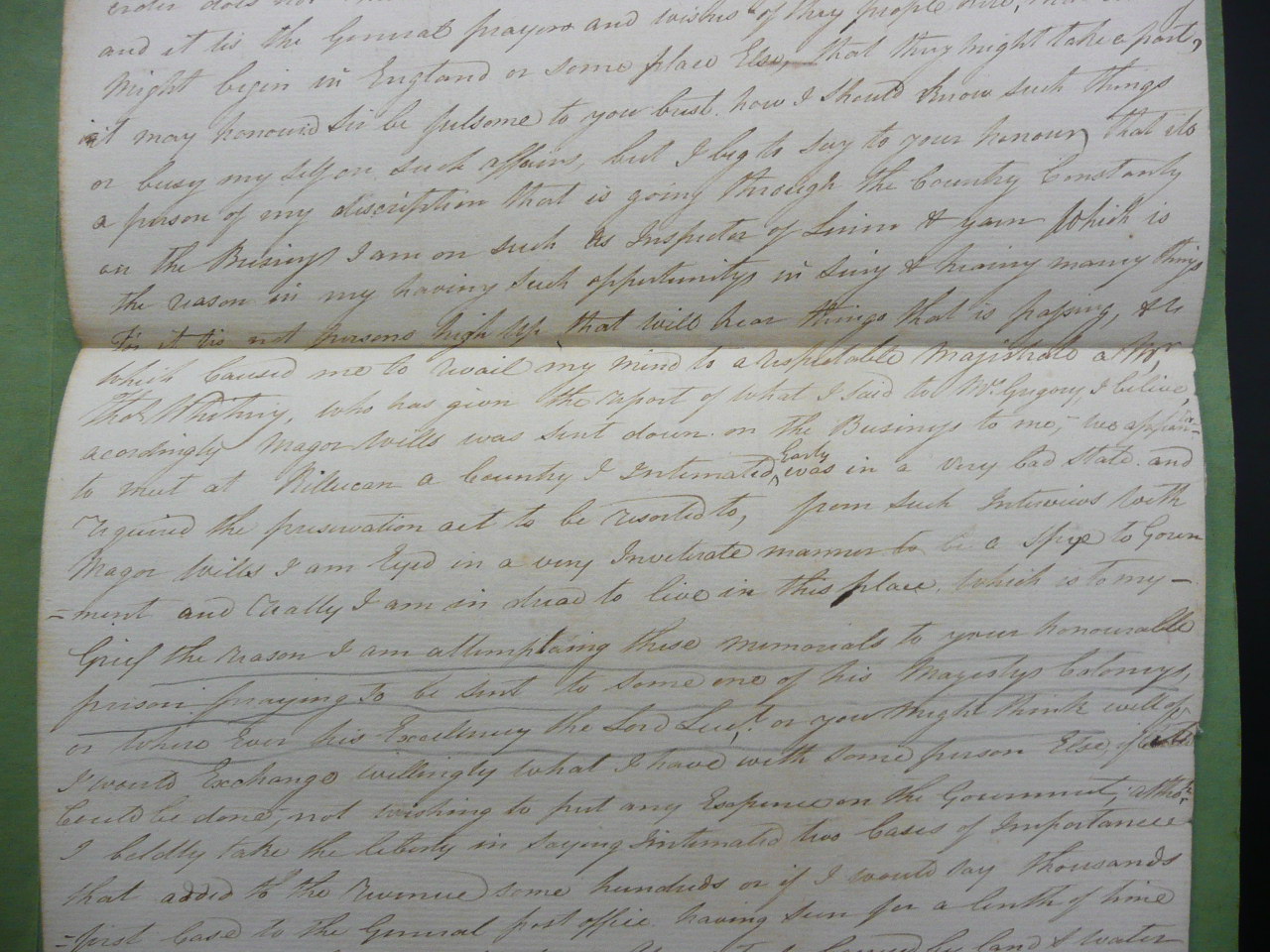
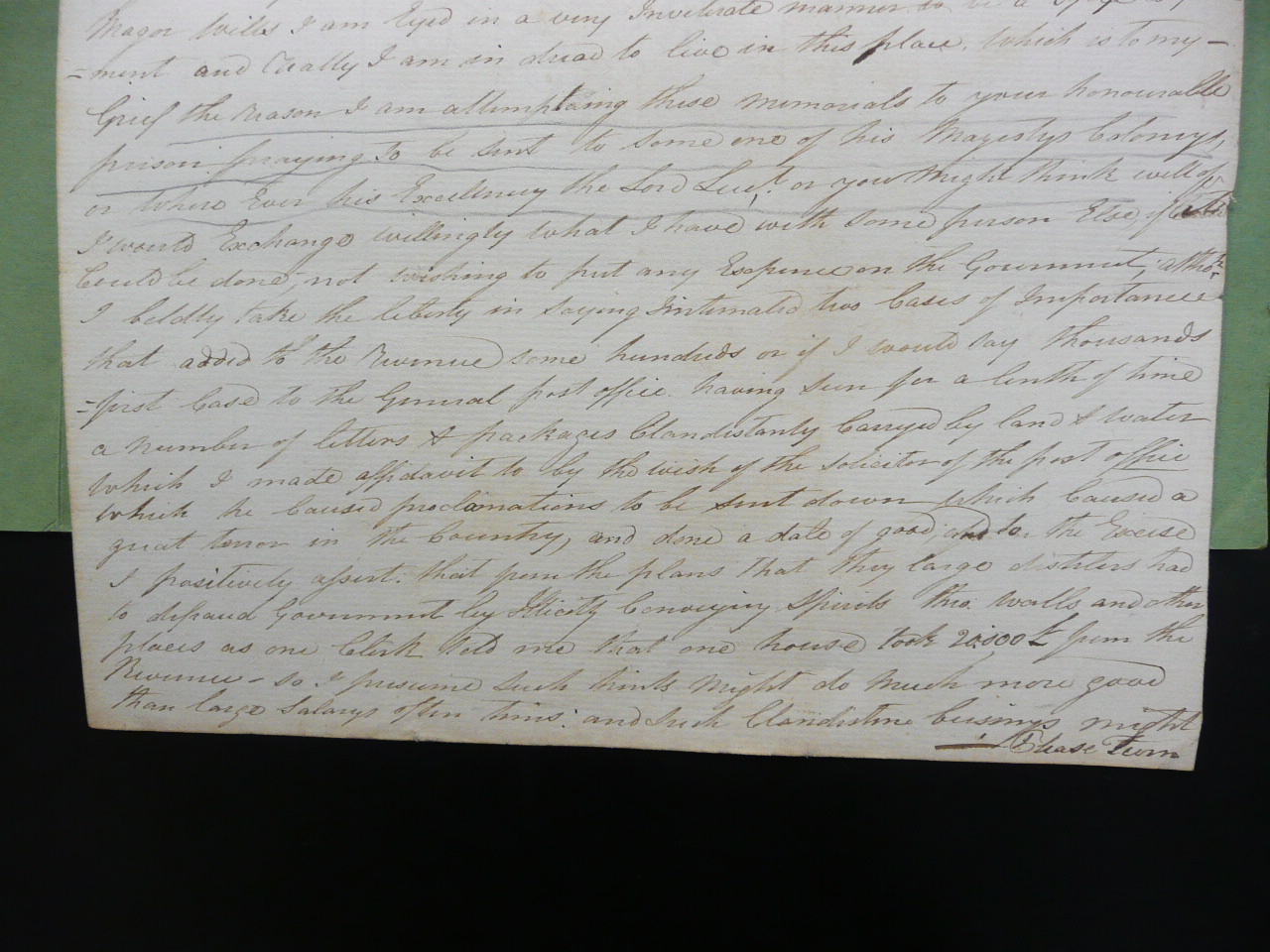
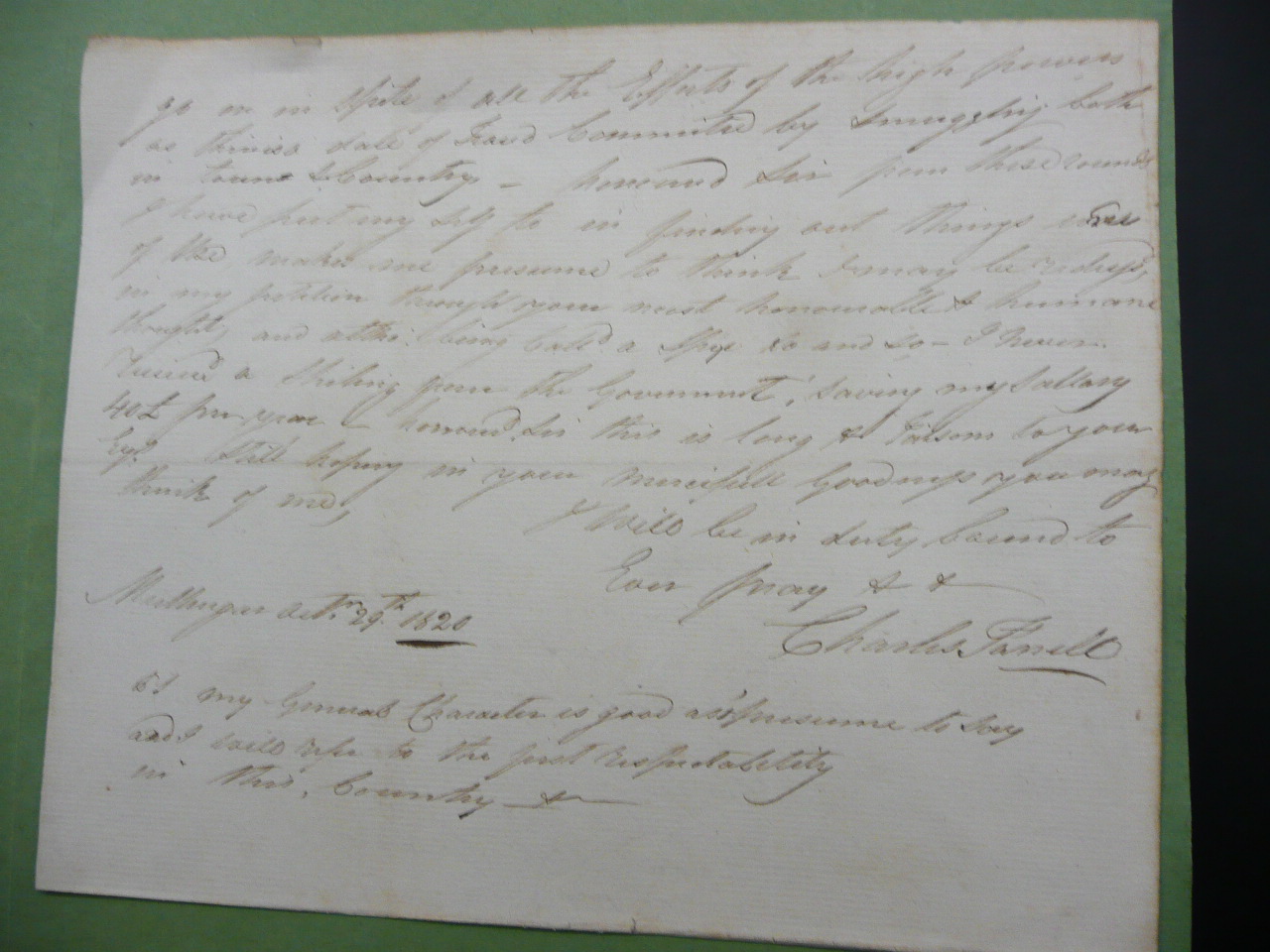
Charles Farrell Plea letter from 1820, courtesy of Paul McCotter’s Report, 2012, and the National Archives Ireland
Charles Farrell petition letter to Charles Grant – CSO/RP/1820/578
Transcribed by Virginia Rundle 18 Nov 2013 (not yet complete)
To the Right Honourable Charles Grant,
Your humble petitioner begs once more to remind your honoured person to the grievous and most calumniate state I lie under as being called a Government Spy. I dare say your honour may be well aware of such a name going out in truth or lies is a melancholy thing to a person, true it is I have given such information as to — a d—o good, if adhere to; both to lives and property and also coming at the head of these inform systems that is — on now to a long extent, as perhaps in junior years by the —- orders and feel as much exasperated to do harm if in their power against the Government if anything would rise in any other quarter as there is a dale of poverty and —- prevailing in the community now that they — order does not know what to be at. Expecting fairly there will be revolution and it this the Gems at prayers and wishes of they people —- that something might begin in England or some place else that they might take apart it may honoured sir be fulsome to your bust. Now I should know such things or busy my life on such affairs but I beg to say to your honour that to a person of any dissipation that is going through the country constantly as the business I am on such as inspector of linen and —- which is the reason in my having such opportunities in seeing and hearing many things for it is with persons highest that will hear things that is —- thus it has caused me to avail my mind to a respectable magistrate —— has thinking who has given the report of what I said to Mr Gregory, I believe accordingly Major Wills was sent down on the business to me, his application to grant at Killican a country, I intimated early was in a very bad state and required the preservation act to be resorted to, from such interviews with Major Wills I am eyed in a very Inveterate manner to be a spy to G—must and really I am in dread to live in this place which is to my grief the reason I am attempting these memorials to your honourable person praying to be sent to some one of his Majesty’s Colony’s as where ever his Excellency the Lord Lieut. Or you might think will of I would exchange willingly what I have with some person. Else of — could be done, not wishing to put any expense on the government, at this I boldly take the liberty in saying —— has cases o importance that added to the revenue some hundreds of if I would say thousands first came to the general post office, having seen for a length of time a number of letters and packages clandestinely conveyed by land and water which I made affidavit to by the wish of the solicitor of the post office which he caused proclamation to be sent down which caused a great tenor in the country and done a late of good who to the excise I positively assent that pass the plans that the cargo dishless had to defraud the government by illicitly conveying spirits that —s and other places as one clerk told one house took 20,000 Pounds from the Revenue – so I presume such hints might do much more good that cargo salarys often times and Irish clandestine might {please turn} go on in spite of all the efforts of the high powers as things date of Fraud commited by — both in towns and countrys – possessed tax from these counties. I have — my life to in finding out these things – what of the maker one presumed to think so many be —- in my petition though your most honourable and humane thought and —- being both a spye so and so – I —–. —- a shilling from the government, saving any salary 40 Pounds per year I honoured – this is long and —– to your eyes. Still hoping in your merciful goodness you may think of me.
I will be in ever bound to ever pray s—Charles Farrell
Mullingar Oct 29 1820
POSTSCRIPT: CF my general character is good as I presume to — and I —- — to the first respectability in this country.
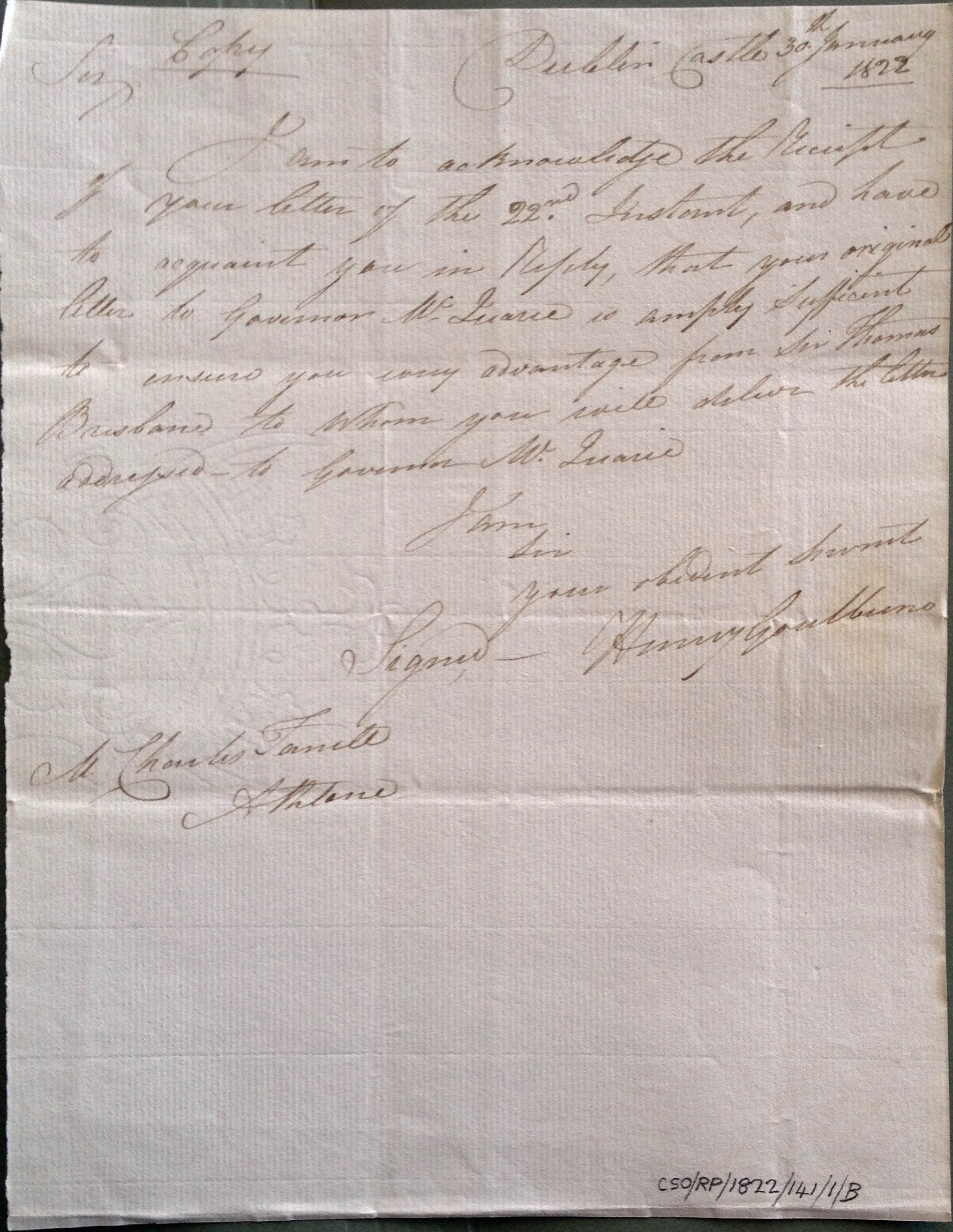
Reply letter from Henry Goulburn, 30 January 1822, Dublin Castle
Image courtesy of the National Archives Ireland
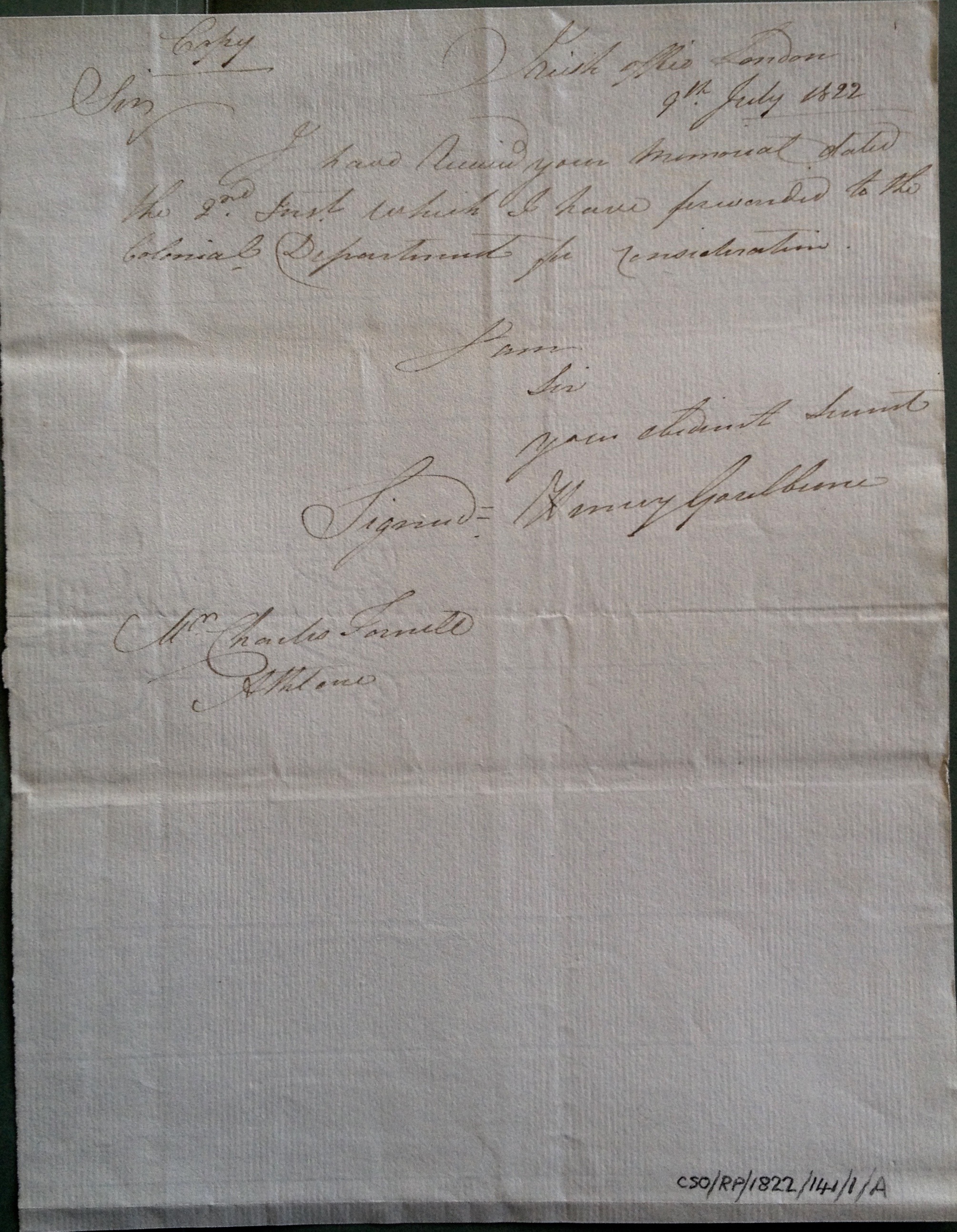
Reply letter from Henry Goulburn, 9 July 1822, Irish Office, London
Image courtesy of the National Archives Ireland
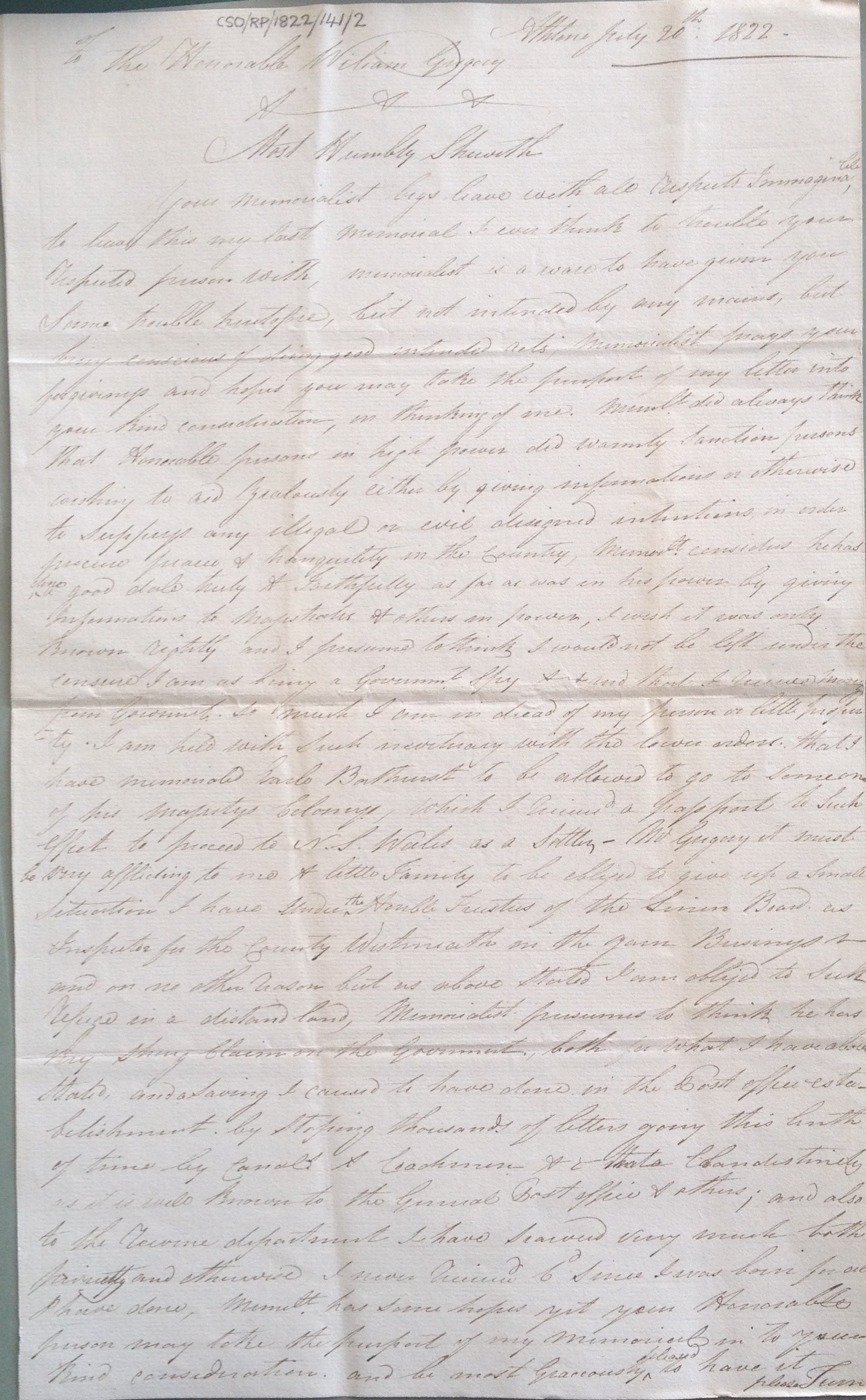
Charles Farrell Letter page 1, dated 20 July 1822, Athlone, Westmeath, Ireland (NAI)
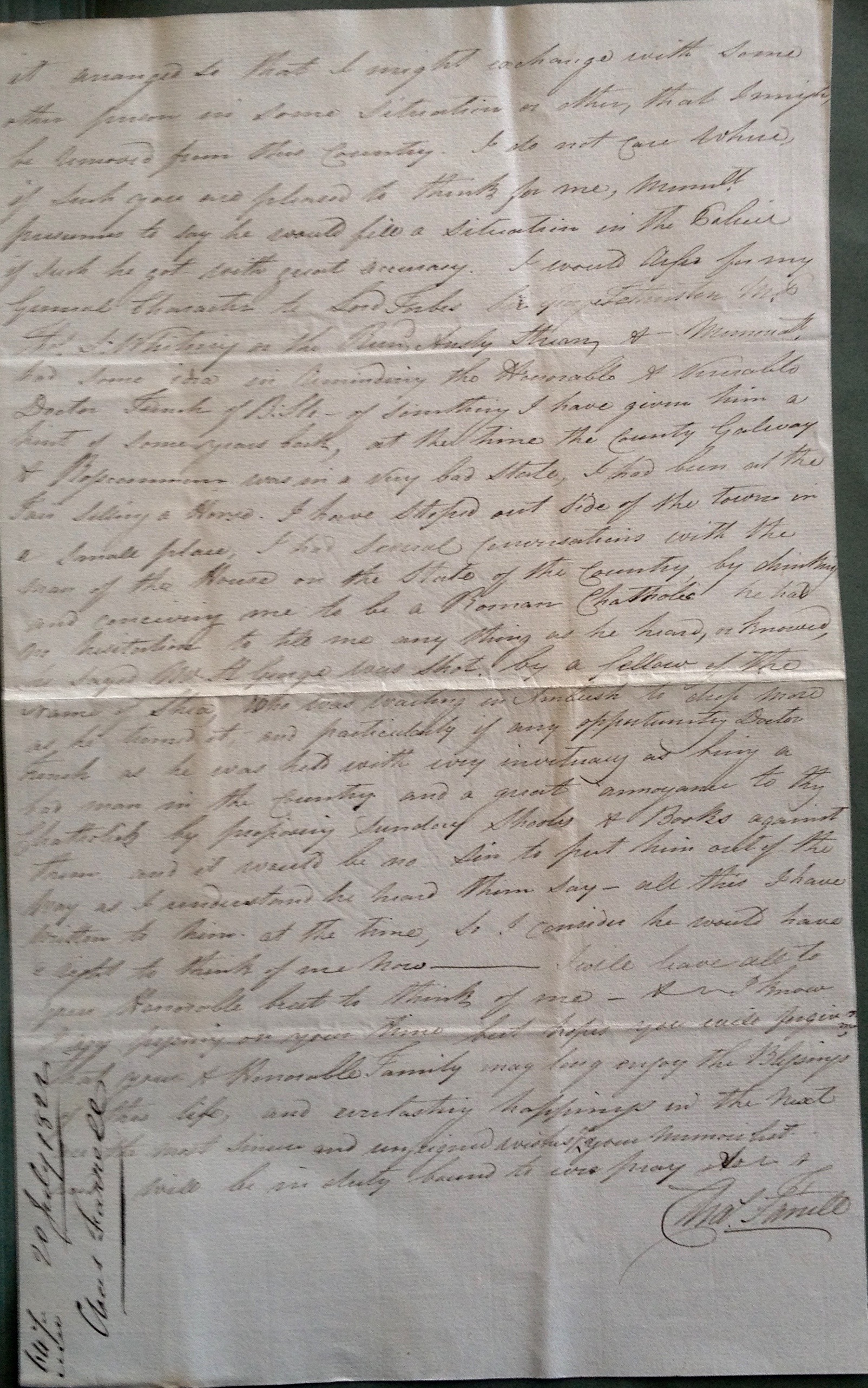
Charles Farrell Letter, page 2, dated 20 July 1822, Athlone, Westmeath, Ireland (NAI)
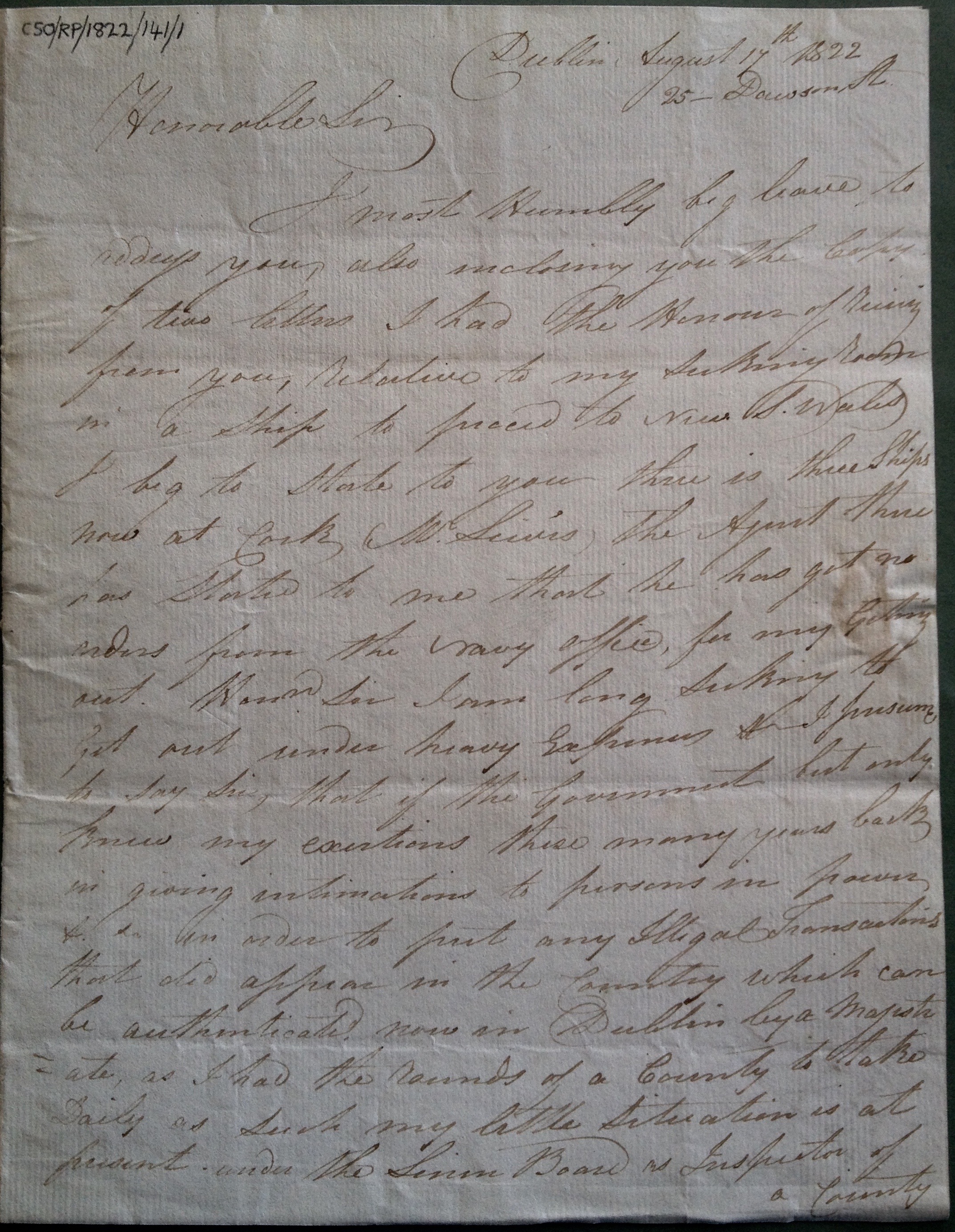
Charles Farrell Letter, page 1, 17 August 1822, 25 Dawson Street, Dublin, Ireland
Image courtesy of the National Archives Ireland
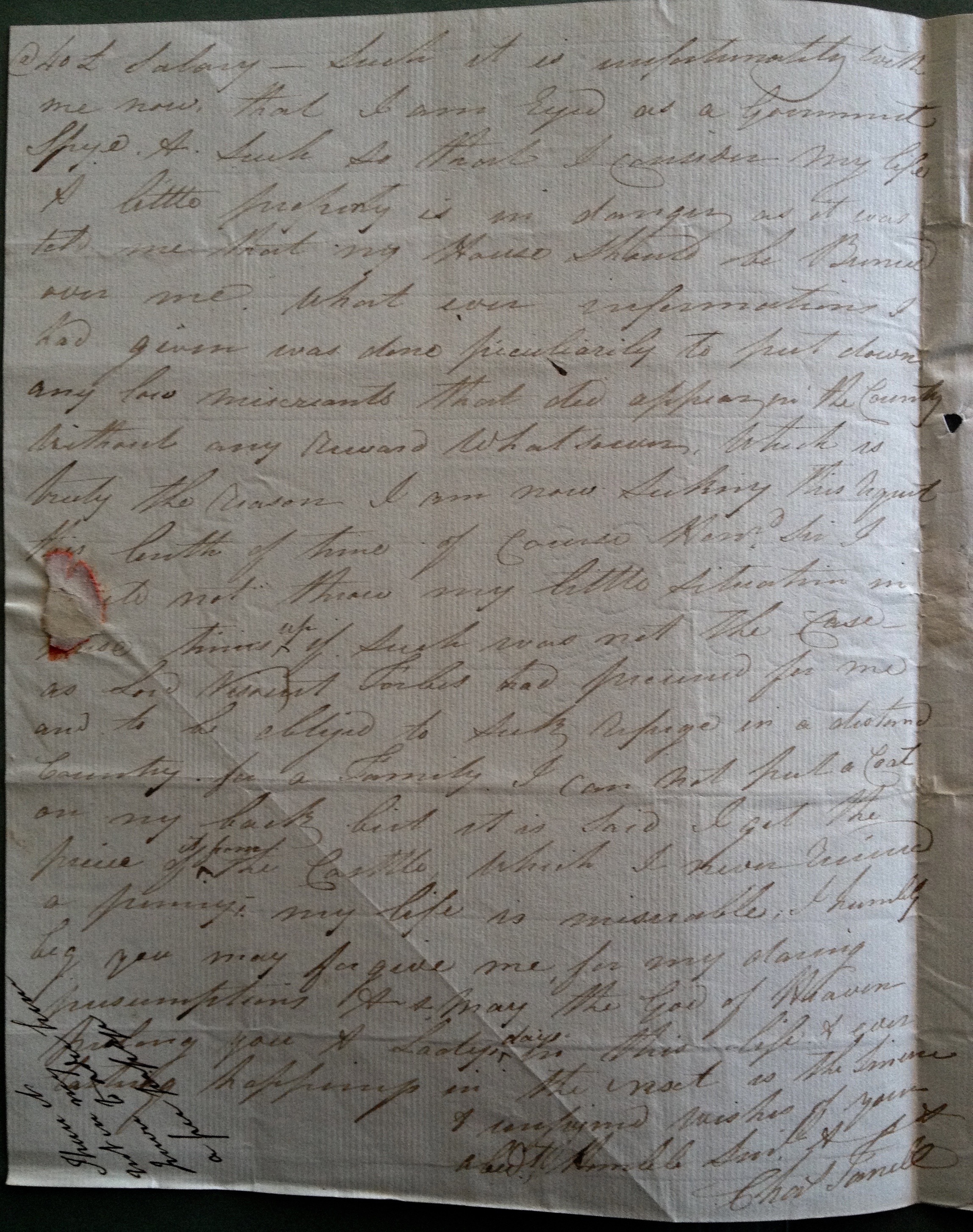
Charles Farrell Letter, page 2, 17 August 1822, 25 Dawson Street, Dublin, Ireland
Image courtesy of the National Archives Ireland
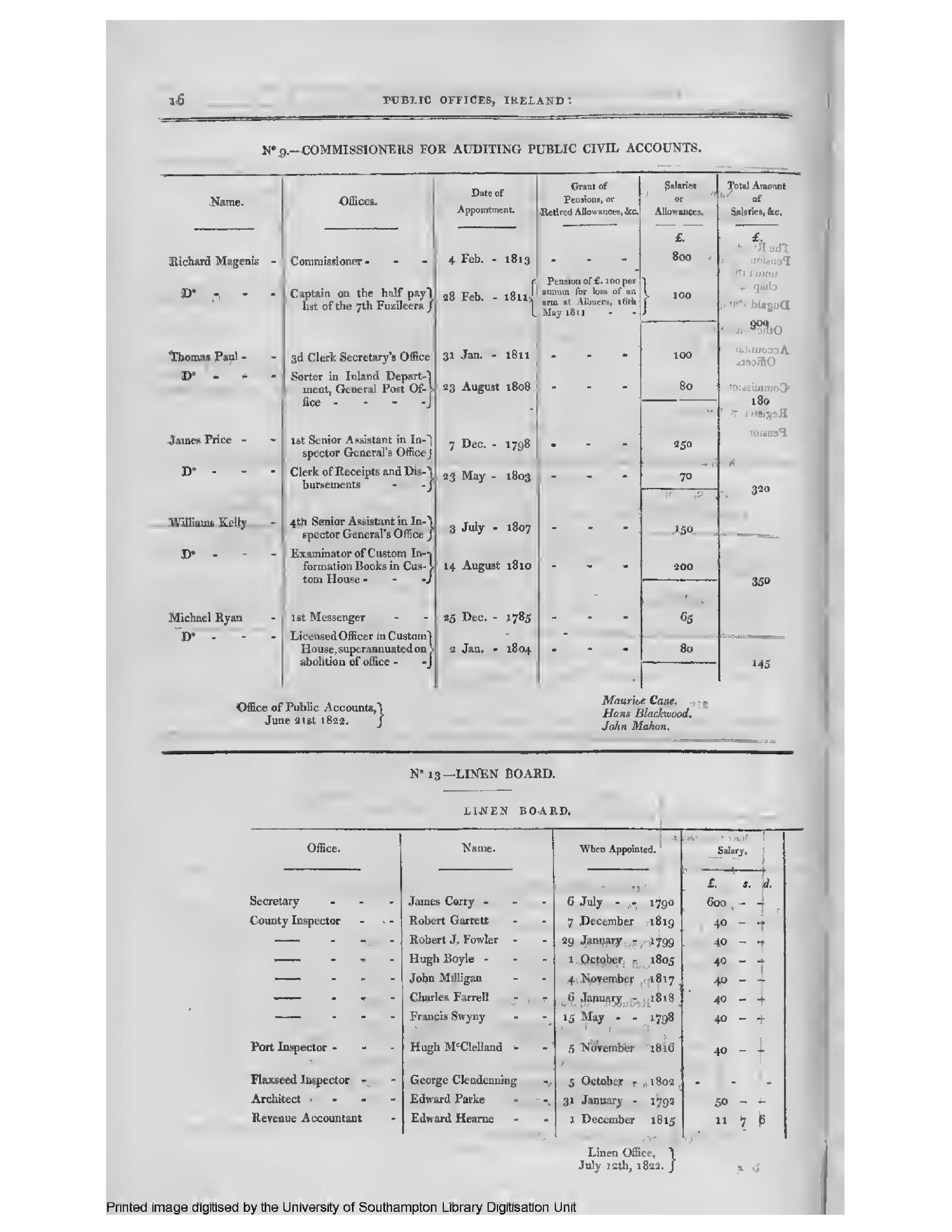
Appointment of Charles Farrell to the Linen Board, Ireland 6 January 1818
Some of my research into the life of Charles Farrell in Ireland involved contacting Westmeath County Council Library to see if there was some material about the Farrells and any extended family.
Westmeath County Council – Confirmation Receipt (Do Not Reply)
To: virginia@arundle.com
Dear Virginia Rundle
Your enquiry/complaint/comment has been received and a member of our staff will be in contact with you shortly.
This is an automated response.
Date Received: 01/12/2013
Enquiry/Complaint/Comment: Charles Farrell Jnr born 1784
Details: Dear Sirs, I wondered if you had any details about Charles Farrell Jnr or his family in your library files. He was a linen inspector. I have found details from the national archives of Ireland that he was suspected of being a spy and sent plead letters to Charles Grant, Chief Secretary, Dublin Castle, stating that he had been marked out for suspicion, because of his assistance to government, 25 October 1821. In one of the letters asking for a land grant in NSW he gave his address as Althone, Westmeath. I wondered if you had any information about the Farrell family from this area? He died in Port Macquarie, NSW in 1842. My husband is his direct descendant. Kind regards Virginia Rundle
Dear Virginia Rundle,
Your e-mail to Westmeath County Council was forwarded to me for reply.
I have made a search of the various resources at my disposal and have found one reference which almost certainly relates to your Charles Farrell. It is a deed of 19 December 1820 and the transcript which is preserved in the Burgess Papers in Athlone Library reads:
19 December 1820. Rev Annesley Strean of St. Peter’s M.D. clk and Charles Farrell, gent. ALL THAT house in the Main Street of Athlone between Daniel Maher’s house or the passage leading to the yard on the east and Michael Moran’s house in the west, and on the north the Main Street, south Michael Moran’s yard, for LIVES: John Strean, Annesley Wm Strean & Edward Farrell, at £32 p.a. WITNESS: William Healy of Athlone, Co Westmeath linen weaver. Bernard Kelly, Mastr Extr.
Do you know what religion Charles Farrell might have had? Annesley Strean who was leasing the house to Charles was the Church of Ireland (Protestant) minister for St. Peter’s Parish, Athlone and was also a medical doctor. The coincidence of one of the witnesses being a linen weaver would seem to suggest that we have the right Charles Farrell. The Kelly family in Athlone were also involved in the linen trade. The surname Farrell is very much associated with County Longford although it has occurred in Athlone since the 17th century at least. If Charles was Catholic and a native of Athlone records of his marriage or birth of his children might be found in the records of St Peter’s Roman Catholic parish in Athlone. These have been indexed by the County Roscommon Heritage Centre in Strokestown, Co Roscommon. If, however, Charles was Church of Ireland the records of St Peter’s C.of I for the 19th century are no longer extant.
The house that Charles leased in 1820 in Main Street might well be the premises which today houses Sean’s Bar which is considered to be one of the oldest bars in Ireland.
I will keep an eye out for any other reference to Charles Farrell in Athlone. While the above adds very little to what you already know I hope it may be of interest
Kind regards
Gearoid
5 December 2013
Gearoid O’Brien, Senior Executive Librarian,
Westmeath County Library Service,
Aidan Heavey Library, Athlone Civic Centre,
Church Street, Athlone, Co Westmeath.
Dear Gearoid,
Thank you for your interesting reply. It is so kind of you to take the time to reply to me, and is much appreciated. My laptop is in for repairs so i have resorted to my mini iPad and am finger typing most laboriously! I asked a few other Farrell descendants and they are of the opinion that Charles was a catholic. I had their reply this morning, so am quickly replying to your email. We may then be in luck with Catholic Church records. Interesting the link also with witness Edward Farrell in your doc. Charles Farrell jnr. (1784 -1842) named his youngest son Edward (b1820) and elder son Lawrence (b1814). There may be a marriage and baptisms records. We also know that his wife was named Mary Cuffe and Mary’ s brother John Cuffe accompanied them to Australia aboard the Ardent in 1824. Mary Cuffe Farrell died aboard during the journey. When Charles remarried to Charlotte Meredith they married in St Mary s chapel – now St Mary’s Cathedral – the catholic cathedral here in Sydney. The eldest son from their marriage was called James Lawrence. Not sure if they are following Irish naming traditions – but hoping! Other sons from his second marriage were named Charles Frederick and William Thomas. Two other daughters from this second marriage were named Mary Elizabeth and Charlotte Rosina.
I would be most happy to pay for a parish record search – if this is possible? I have a PayPal account, if that helps? It is so kind of you to look out for other docs. We are having a most interesting time here in Sydney trying to unravel exactly where we came from…
My kindest regards
Virginia Rundle
Sent from my iPad
I happily corresponded with Gearoid who very kindly searched the records of St Mary’s Athlone, without success. At some point in the future I will take up his suggestion to contact the County Roscommon Heritage Centre and the Genealogy Centre in Church Street, Strokestown, Roscommon.
Geoff and I visited Ireland in August and September 2016 but unfortunately there was no time to seek out the information above in Stokestown. We did however make a point of stopping off in Athlone to see where Charles had lived before leaving Ireland and had worked as a linen inspector. It was a glorious sunny and warm day, and we both decided that we would make the most of the day, and it seemed a shame on a beautiful day to spend time in a Library.
As soon as we arrived in Main Street we knew that this area was correct, because Main Street was right beside the River Shannon, and directly next to a lock in the river, which would have meant all traffic on the river would have stopped at the Main Street lock, and would have been the perfect point for inspection. Nearby we had views of Athlone Castle, which was nearby to the bridge, and opposite St Peters Church. All these landmarks confirmed the email that Gearoid had sent me as the place that Charles Farrell had lived and worked. The fact that one of the plea letters also gave Charles’ address as Athlone would seem to confirm that Charles lived in Athlone from December 1820 until he obtained safe passage to Australia.
Sean’s Bar, Main Street, Athlone, Ireland
Athlone Castle, Main Street, viewed from Sean’s Bar
View of bridge from the waterfront nearby to Sean’s Bar
Geoffrey Philip Farrell Rundle, standing on waterfront side of Sean’s Bar, Athlone
Athlone Lock, opposite Sean’s Bar
Athlone Lock, office and river height measure for the Shannon
Cruise boat in Athlone Lock, a working lock along the Shannon River
Shannon River, Athlone, Ireland
St Peters Church, Barrack Street, Athlone, Ireland, opposite Athlone Castle
Geoff and I stayed in Dublin for 5 days of research and touring. During that time on one of our walks, we found 25 Dawson Street, as mentioned in Charles Farrell’s letter. We felt sure that this was the same building that he had lived in when he wrote his letter dated 17 August 1822.
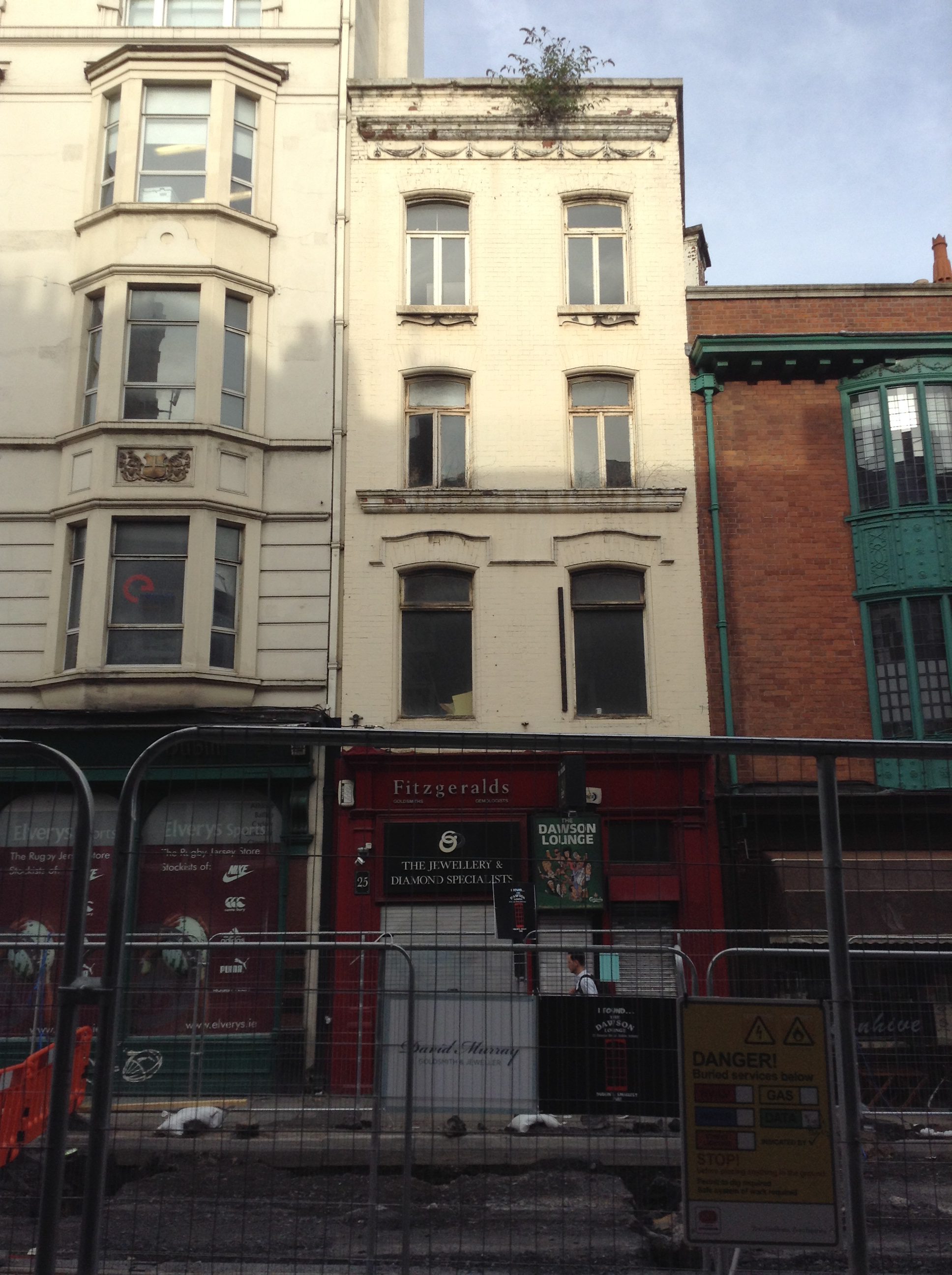
25 Dawson Street, Dublin, Ireland, the house where Charles Farrell wrote his plea letter dated 17 August 1822.
Research into Charles Farrell and his Irish family finishes here for now. I hope in the near future that I will be able to collaborate with other Charles Farrell researchers and add to this chapter. It is mooted that a reunion will take place in October next year and to that end I have been asked by Ellen Brown to put into writing my research, so that information can be shared for further research to continue amongst the descendants.
Virginia Rundle, 26 June 2017
Bibliography:
Westmeath Library
National Archives of Ireland
Geoff and Virginia Rundle’s photos from 2016 trip to Ireland
University of Southampton Library, England

